![]()
![]()
![]()
Use LEFT and RIGHT arrow keys to navigate between flashcards;
Use UP and DOWN arrow keys to flip the card;
H to show hint;
A reads text to speech;
83 Cards in this Set
- Front
- Back
|
What is a chromosome? |
DNA molecules & its associated proteins are packaged into threadlike structure in the nucleus. -carry the genes in a linear sequence |
|
|
What is the number of chromosome in a prokaryote? |
one circular chromesome in the nucleoid |
|
|
eukaryote has how many chromosomes? |
multiple linear chromsome in the nucleus & depends on cell type. |
|
|
what is a diploid cell? |
contains 2 copies of each chromosome -one set of chromosome is donated from each parent |
|
|
what is homologs? |
2 copies of a given chromosome |
|
|
what is haploid cell? |
cell contains a single copy of each chromosome & involved in sexual reproduction |
|
|
what is a polyploid? |
cell has more than 2 copies of each chrom |
|
|
most prokaryotic cells are? |
haploid cell (bacteria) |
|
|
HUMAN cells include both what? |
diploid & haploid |
|
|
what are somatic cells? |
diploid (44 autosomes + 2 sex chromsomes XY & XX)
|
|
|
Sex cells are what? |
haploid (22 autosomes + 1 sex chromosome X or Y) |
|
|
The number of chromosomes are different in ______. |
organisms |
|
|
Diploid means? |
2N only one division mitosis |
|
|
Haploid means? |
N 2 divisions meiosis |
|
|
What is chromatin? |
eukaryotic cells, a given region of DNA with its associated protein |
|
|
The majority of associated protein in eukaryotic cells are what? |
small, basic proteins called histones |
|
|
what are non-histone proteins? |
other proteins associated with eukaryotic chromosome |
|
|
what is the chromosome structure of prokaryotes? |
-bacteria have no histones or nucleosome -uses histone-like proteins or polyamides or other proteins -1 mm long circular DNA of E.coli packaged into a cell that is only 1 micrometer in length ( 1 micrometer = 0.001 mm) |
|
|
some prokaryotes also carry one ore more smaller independednt circular DNA in their cytoplasm called what? |
-PLASMIDS -not essential for bacterial growth -confer desirable traits -often present in many complete copies per cell -can transfer btw bacteria |
|
|
what is the chromosome structure in eukaryotes? |
always contained w/in a membrane-bound nucleus
|
|
|
the human somatic cells are diploid which contains 46 chromosomes which contains... |
44 chromosomes = autosome 2 chromosomes = sex chromosome |
|
|
the human sex cell are haploid which contains 23 chromosomes which contains.... |
22 chromosomes = autsome 1 chromosome = sex chromsome |
|
|
multiple chromsomes, each with a linear molecule of DNA tightly packaged by small basic proteins are called what? |
histones, 2m of DNA packaged into nucleus of 10-15 micrometer in diameter. |
|
|
What is the basic unit of chromosome in eukaryotes? |
NUCLEOSOME |
|
|
each nucleosome is complex of what? |
a histone core & DNA wrapped around it |
|
|
the most tightly associated with a histone core is called what? |
CORE DNA |
|
|
What is a linker DNA? |
DNA btw each nucleosome (20-60bp) |
|
|
what is a histone core? |
eight histone proteins of located in the center of nucleosome |
|
|
eukaryotic cells commonly contain five abundant histones which are? |
H1, H2A, H2B, H3, H4 |
|
|
A histone core contains 2 copies of what? |
H1 (linker histone) H2A, H2B, H3, H4, |
|
|
147 base pairs of DNA wrapped ______ times around a histone core |
1.65 times |
|
|
1 molecule of H1 is bound to what |
linker DNA btw nucleosomes |
|
|
DNA is compacted approximately.... |
sixfold |
|
|
Nucleosome structure... |
-basic repeating unit of chromatin -made up of 5 histones -provides lowest level of compaction of double strand DNA into the nucleus -Associates w/ TRANSCRIPTIOn
|
|
|
what are histones? |
positively charged -high proportion of lysine and argentine -IN any cells, there are stretches of DNA that are not packaged into nucleosomes. -THESES sites contain non-histones |
|
|
Histones are modified and related to what? List the types of processes... |
gene expression 1.) acetylation : lysine 2.) methylation : lysine & arginine 3.) phosphorylation: serine & theronine 4.) Sumoylation: lysine ubiquination |
|
|
Histone modifcation occur primarily within the what? |
histone amino terminal tails protruding from the surface of nucleosome as well as on globular core region |
|
|
what is acetylation? what is methylation? |
-intro of an acetyl grp by HAT(histone acetyl transferase) - decompaction! -a methyl grp introduced by HDAC (stops decompacion or compaction) |
|
|
Which enzyme decompact (less compact) /loosens/relaxed the DNA? |
HAT (histone acetyl transferase |
|
|
Which enzyme compacts/tightens the DNA? |
HDAC ( histone deactyletransferase) |
|
|
look at image |
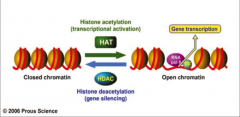
|
|
|
DNA modification regulate gene transcription, which one is most common? |
methylation AKA epigentic modification associated with cancer, mental retardation, aging. |
|
|
look at image |
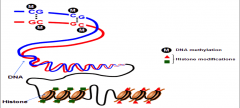
|
|
|
where is the 1 stage of DNA packaged for eukaryotes? |
NUCLEOSOMe |
|
|
Packing yields chromain fiber _____ nm in diameter? |
10; 200 bp repeating unit 80 bp spacer btw chromatosomes appears as "BEADS of STRINGS" under microscope |
|
|
look at image |
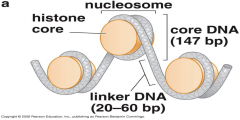
|
|
|
Further condensation by coiling into ___nm fibers? |
-30 -structure not defined -interactin btw H1 plays important role in condensation |
|
|
List the levels that happens in DNA packaging in a nucleosome? |
1.) package yield chromatin fiber 10 nm diameter 2.) further condense by coiling 30 nm fibers 3.)30 nm fiber forms loops of 40-90 kb = nuclear scaffold. |
|
|
what is a nuclear scaffold? |
30 nm fibers forms loop of 40-90 kb |
|
|
what is euchromatin? |
-stains poor, -open structure under light microscope - 30 nm state (electron microscope) -10% euchromaitin is 10 nm state -transcriptionally active euchromatin |
|
|
what is heterochromatin? |
-stains dense -condensed appearance under microscope -inactive for transcription -deactylate or methylate |
|
|
Chromatin structure varies during what? |
cell cycle |
|
|
In Interphase (non-dividing) most chromatin (90%) is decondensed... |
called euchromaint -transcriptionally active -stain poor -open strcuture -30 nm state |
|
|
in interphase 10% euchromatin... |
undergo transcription -even more decondense -10 nm state |
|
|
in interphase chromatin 10%... |
-called heterochromatin -highly condensed -transcriptionally silent -stain densely -more condensed appearance |
|
|
what is Mitosis? |
chromsomes = condensed to facilitate movement into daughter cells -30 nm chromosomes fold upon themselves & condense 10,000 fold -organized in large loops attached to protein scaffold -transcription ceases |
|
|
look at image |
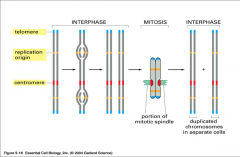
|
|
|
what are the levels of DNA packaging / morphology? |
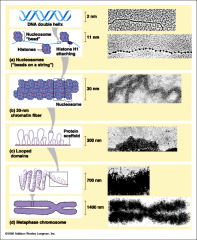
-DNA -Nucleosome -chromatin fiber -chromatin fiber w/protein scaffolding -metaphase chromosome |
|
|
what is DNA packaging? |
-make dna readily fit inside the cell -protect the DNA from damage -efficiently transmit DNA to both daughter cells |
|
|
what is a genome? |
-entirety of an organisms hereditary info. (organism complete set of DNA) -each genome has all the info needed to build and maintaining that organism -info. encoded either DNA or RNA
|
|
|
-genome size is related to what? |
complexity of organism |
|
|
-genome includes both what? |
coding and non-coding sequences of DNA |
|
|
the less complex the organism the _____ the gene density |
higher |
|
|
what are the 2 factors that contribute to the decreased gene density in eukaryotic cells? |
1.) intron (increased in gene size) 2.) intergenic sequences( increased in DNA btw genes ) |
|
|
what is a human genome? |
all of the genes found in a single indigo. = 30,000-40,000 genes neatly packaged into 46 chrom. |
|
|
what is a gene? |
unit hereditary in a living organism -hold info to build and maintain organism cell and pass genetic traits to offspring |
|
|
what are alleles? |
alternative form of a gene for a diploid organism (one member of a pair)- -organism has 2 alleles fro each trait |
|
|
what is homozygous? |
2 alleles of a gene are same for a single trait |
|
|
heterozygous? |
2 allelles of a gene are diff. but code for a single trait -(1 dominant, 1 recessive) |
|
|
what is genotype? |
dna nucleotide sequence responsible for a trait or phenotype |
|
|
phenotype? |
trait or group of traits resulting from transcription & translation in genes -organisms observable characterisitics |
|
|
what is the gene structure of prokaryotes? |
polycistronic: 1 mRNA can translated to more than one polypeptide -E.Coli genome is composed almost entierely genes |
|
|
what is the gene strcuture in eukaryotes? |
monocistronic 1 mRNA translated to only 1 protein -intergenic sequences is a stretch of DNA sequences located btw clusters of genes -genes = small propotion of eukaryotic chrome. DNA |
|
|
In eukarytoes, gene structure include what? |
1.) introns 2.) extons |
|
|
what is introns & exons? |
1.) sequence of DNA situated btw exons that will be removed before translation of mRNA and does not function in coding for protein synthesis 2.) sequence o DNA that will be transcribed to mRNA, then directed protein synthesis |
|
|
what are the functions of a gene? |
1.) stable storage of genetic info 2.) transmission of genetic info |
|
|
Genes provides the source of what for the syntheisis of proteins? |
info |
|
|
in Genes, Some RNA in a cell serves as a what? |
template for replication of genetic info that is passed on to daughter cells |
|
|
what is a genome mutation? |
changes in the # of chromosomes -often observed as increased # of chromosomes (aneuploidy) -ex: Down syndrome |
|
|
what is chromosomal mutation? |
changes in structure of entire chromosome -EX: Angelman syndrome is caused by micro deletion in chrome. 15 |
|
|
what is gene mutation? |
changes in DNA sequence of single gene -EX: cystic fibrosis caused by CFTR gene mutation ex: sickle cell |
|
|
Genome & chromsomal mutattion can be seen in what? |
-Karotyping -Flow cytometry -FISH -CGH |
|
|
Gene mutation or mutations at nucleotide sequence level can be seen in what? |
-biochemical method phenotype -moclecular methods DNA sequence |

